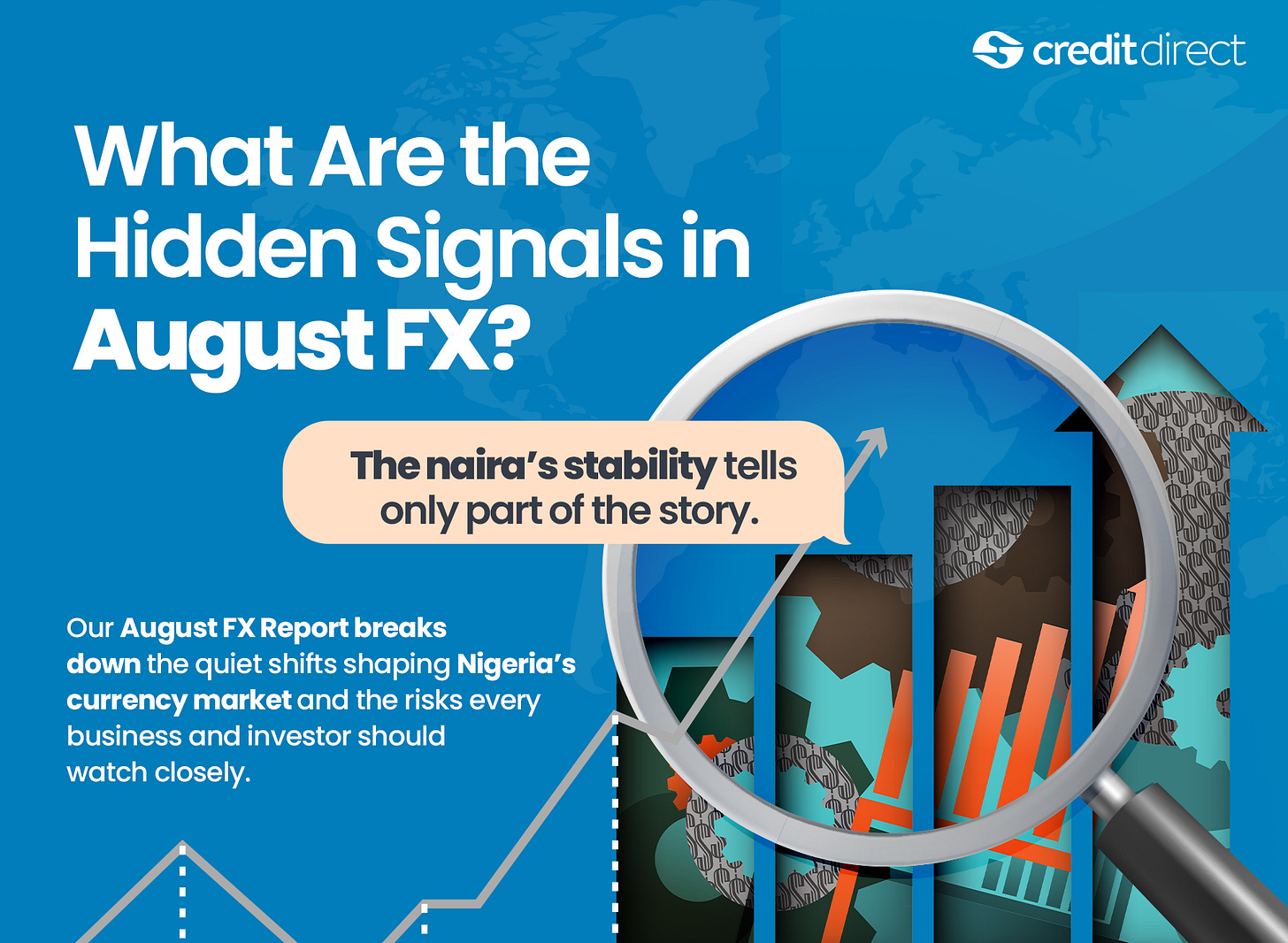Next-day beats next week
Moove, Jumia (yes) and Open Banking
If you missed last week’s newsletters, catch up here and here. If this newsletter was shared with you, subscribe here for free:
TOGETHER WITH CREDIT DIRECT
Everyone sees the headline rate, but not everyone understands the forces behind it. The real FX story is about stability, risks, and what they mean for businesses and households.
This month’s FX Report breaks it all down, from foreign inflows to oil price pressure, and gives you a clearer view of what to expect next.
Moove is speaking to investors about raising fresh funding at a valuation of $2 billion, according to Bloomberg. New unicorn incoming? It helps to remember that this is a modern fundraising ritual; you say the valuation out loud in a reputable publication, and if it happens, the headline was prescient, no big deal. It still feels clear that Moove is Africa’s next unicorn anyway (do they still qualify as African given their almost exclusive focus on markets like India, UAE and the US?)
Investors Believe Next-Day Beats Next Week
The broad promise of this newsletter is simple: because most business and technology reporting is sauceless stuff, we’ll bring the sauce, connect dots, and hopefully make you chuckle on the way to an insight. The implied promise, if you’ve been here long enough, is that we’ll always find a way to talk about Jumia. There was a time when Godwin Emefiele shared that privilege, but he’s cooling his heels in jail, and far be it from me to kick a man when he’s down.
This isn’t the boring “Jumia made another loss; will the Amazon-of-Africa ever figure it out?” spiel. Around here, Jumia is a hammer to every nail. Consumer story? Jumia. B2B angle? Jumia again. We use it to drive home the point on whatever’s really going on.
If you’re not already in on the joke, now you know.
All of that to say, there’s even more Jumia this week. This is the only appropriate reaction:
A big theme for Jumia this year is China. Since Temu, Shein, and a parade of Chinese retailers stormed African markets in 2024, they’ve plastered the internet with ads. There was a brief moment when the only safe place from Temu’s banners was your dreams. The pitch—endless goods, rock bottom prices, free delivery—was always going to land somewhere. Then the U.S. turned the screws with tariffs, and Africa looked even more attractive.
The very valid question in everyone’s minds (yes, admit you thought about it) was: would Jumia get beaten in e-commerce by Chinese retailers? A lot has been said (some of it unfair) about how the new players have figured out food delivery while Jumia couldn’t, and many wondered out loud if that would play out here once again.
Thankfully, because Jumia is a public company, it confronted those fears head-on and even began to name-check Temu and Shein in the second quarter of 2025. I wrote about it for Semafor here.
After that Q2 earnings call, Jumia’s CEO did some press rounds, speaking on the same topic and explaining why and how they remain in the best place to win this competition.
“We reorganized sourcing, brought in suppliers from China, and drastically cut our cost base. ….This puts us in a strong position to compete with international platforms like Temu, which entered Nigeria in late 2024. They spent millions on marketing and gave $100 vouchers, but over time, they had to cut back. Their nationwide free delivery is unsustainable — for example, delivering to rural areas like *Maiduguri is extremely costly.” - Francis Dufay via Rest Of World.
Editor's note: Everyone name-drops far-flung places like Maiduguri and Nembe when they want to complain about logistics in Nigeria, yet Tolaram (Indomie, Hypo, etc.), Dangote, Cowbell Milk, DHL, Coca-Cola, and WAEC have since figured out how to get items to these places.
Dufay also met with investors and analysts, reiterating this key message. Broadly, Jumia believes its moat consists of:
Next-day delivery in its key markets. Temu and Shein typically need anywhere from 7 to 16 days to deliver any item
Deep reach (it began its push into peri-rural areas in 2024 and says a lot of orders now come from outside urban areas)
An existing customer base (say what you will, but Jumia has had around 2 million customers for years)
Because of the nature and pricing of the items on Temu and Shein, a lot of them are pretty much nonsense, and you might not know until they get to you. Jumia still has pay on delivery, and sort of soothes that worry
Anyway, Jumia’s meeting with analysts, where it probably said all of these things (public companies really can’t tell investors and analysts anything they have not already publicly disclosed).
One sell-side analyst, RBC Capital Management, came out of that meeting feeling really optimistic and pushed his target price for Jumia from $6 to $15. For him, macroeconomic stability in Nigeria and Egypt will lead to an uplift for Jumia.
Also, I mentioned in a previous newsletter that Jumia increased its take rate a.k.a commission it charges the sellers who use its platform, with very little pushback. RBC Capital believes Jumia is in a position to increase that take rate in the next 3-4 years, theoretically increasing its revenue.
Finally, it’ll come down to a sense that Temu and Shein’s focus on Africa proves there’s a viable market here and that Jumia is the horse to back to capture that market. The commitment to becoming profitable in 2027 won’t hurt either.
Jumia will close trading this week at almost $12 per share, the highest it has traded this year, up from $9 at the start of the week. For Dufay, some good times are here.
Open Banking: why the door hasn’t opened (yet)
Open Banking is slowly becoming the second topic you can get insights on in this newsletter. In April, we exclusively broke the news of the CBN approval of Open banking, targeting an August 2025 go-live date, setting Nigeria up to be the first African market with a full implementation.
Since that scoop, there’s been a lot of silence, but apparently, a lot of movement has been happening behind the scenes.
The general story of getting a loan in Nigeria is this: you open your banking app, tap “Loans,” and if your history suggests you have the capacity and willingness to pay back, get some money. This is theoretically based on the acceptable risk limit and credit scoring algorithm of your lender of choice.
If you’re not among the 6% of Nigerians who got a bank loan in 2024, you go hunting, and thankfully, you have over 400 options: lending apps and USSD codes for when a smartphone isn’t an option.
It is worth noting that if your bank has not yet offered you a loan, you may be assessed as a subprime borrower. So you may have to pay higher interest rates to digital lenders who are willing to risk lending you money.
This is what happens when the best signals about your risk—your transaction history—are locked up inside banks.
That’s why Open Banking, the simple idea that banks share your data with approved third parties (with your consent), should theoretically transform lending.
One of the discussions at the CBN is a decision on how Open Banking will be implemented.
There are two architectures on the table:
Peer-to-Peer a.k.a the “everyone shakes everyone’s hand” model: each approved fintech plugs into each bank using shared standards, and each bank runs its own consent flow.
Hub-and-Spoke, where a neutral switchboard is in the middle (think NIBSS). Fintechs onboard once through the hub, and use a single consent service; banks plug in on the other side. The payoff is that open banking can go live as soon as the first bank signs up. The trade-off is that you have a single point of failure.
Why does any of this matter for ordinary people? Because credit in Nigeria, when available, is currently opaquely priced. The default borrower profile consists of: informal income, seasonal cash flows, no long banking history. So they get charged as if they’re guaranteed to default.
With Open Banking, a responsible borrower can point a lender to their actual money trails: market days, POS settlements, salary trickles, bill payments. Suddenly, risk can be priced on truth rather than vibes. That should mean more approvals for the deserving, cheaper rates for good histories, and fewer lenders resorting to shakedown collections to plug data gaps.
*All this of course is theoretical, and we can only hope the implementation is as close to this as possible*
It won’t fix incomes, inflation, or bad actors. But it can change the incentives. Lenders who truly understand a customer’s cash flow can compete on fair pricing and speed rather than who shouts loudest on Instagram. Borrowers who behave well, finally get to signal it across lenders, not just the bank they started with. And regulators get a clearer line of sight into who’s accessing what, under whose consent.
The next step is execution. Accreditation must be straight forward and clear. Consent screens must be written in English—and Nigerian English—that real humans understand. Uptime at the centre must be boringly reliable so “centralised” feels like a feature, not another fragile system.
Do this cleanly and Nigeria’s retail credit market gets a proper brain; fumble it and we’re back to vibes, harassment and expensive lessons masquerading as AI.
Before you run off, please follow our Instagram channel. We may very well show you a few videos this weekend, but how will you see them if you don’t follow us? Oya, do the needful and follow us here.
I really enjoyed writing this newsletter (and a big thanks to Nnanna for editing it, subscribe to his Substack here). Please leave a comment, like, and share if you also enjoyed it. Apart from brand money, hearing back from you is the next best thing about writing Notadeepdive.
See you on Sunday!






